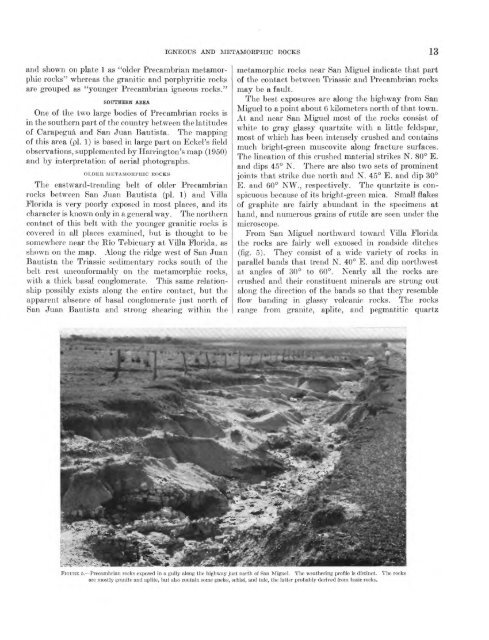Geology and Mineral Resources of Paraguay A Reconnaissance
Geology and Mineral Resources of Paraguay A Reconnaissance
Geology and Mineral Resources of Paraguay A Reconnaissance
- No tags were found...
You also want an ePaper? Increase the reach of your titles
YUMPU automatically turns print PDFs into web optimized ePapers that Google loves.
IGNEOUS AND METAMORPHIC ROCKS 13<strong>and</strong> shown on plate 1 as "older Precambrian metamorpliicrocks" whereas the granitic <strong>and</strong> porphyritic rocksare grouped as "younger Precambrian igneous rocks."SOUTHERN AREAOne <strong>of</strong> the two large bodies <strong>of</strong> Precambrian rocks isin the southern part <strong>of</strong> the country between the latitudes<strong>of</strong> Carapegua <strong>and</strong> San Juan Bautista. The mapping<strong>of</strong> this area (pi. 1) is based in large part on EckePs fieldobservations, supplemented by Harrington's map (1950)<strong>and</strong> by interpretation <strong>of</strong> aerial photographs.OLDER METAMORPHIC ROCKSThe eastward-trending belt <strong>of</strong> older Precambrianrocks between San Juan Bautista (pi. 1) arid VillaFlorida is very poorly exposed in most places, <strong>and</strong> itscharacter is known only in a general way. The northerncontact <strong>of</strong> this belt with the younger granitic rocks iscovered in all places examined, but is thought to besomewhere near the Eio Tebicuary at Villa Florida, asshown on the map. Along the ridge west <strong>of</strong> San JuanBautista the Triassic sedimentary rocks south <strong>of</strong> thebelt rest uri conformably on the metamorphic rocks,with a thick basal conglomerate. This same relationshippossibly exists along the entire contact, but theapparent absence <strong>of</strong> basal conglomerate just north <strong>of</strong>San Juan Bautista <strong>and</strong> strong shearing within themetamorphic rocks near San Miguel indicate that part<strong>of</strong> the contact between Triassic <strong>and</strong> Precambrian rocksmay be a fault.The best exposures are along the highway from SanMiguel to a point about 6 kilometers north <strong>of</strong> that town.At <strong>and</strong> near San Miguel most <strong>of</strong> the rocks consist <strong>of</strong>white to gray glassy quartzite with a little feldspar,most <strong>of</strong> which has been intensely crushed <strong>and</strong> containsmuch bright-green muscovite along fracture surfaces.The lineation <strong>of</strong> this crushed material strikes N. 80° E.<strong>and</strong> dips 45° N. There are also two sets <strong>of</strong> prominentjoints that strike due north <strong>and</strong> N. 45° E. <strong>and</strong> dip 30°E. <strong>and</strong> 60° NW., respectively. The quartzite is conspicuousbecause <strong>of</strong> its bright-green mica. Small flakes<strong>of</strong> graphite are fairly abundant in the specimens ath<strong>and</strong>, <strong>and</strong> numerous grains <strong>of</strong> rutile are seen under themicroscope.From San Miguel northward toward Villa Floridathe rocks are fairly well exoosed in roadside ditches(fig. 5). They consist <strong>of</strong> a wide variety <strong>of</strong> rocks inparallel b<strong>and</strong>s that trend N. 40° E. <strong>and</strong> dip northwestat angles <strong>of</strong> 30° to 60°. Nearly all the rocks arecrushed <strong>and</strong> their constituent minerals are strung outalong the direction <strong>of</strong> the b<strong>and</strong>s so that they resembleflow b<strong>and</strong>ing in glassy volcanic rocks. The rocksrange from granite, aplite, <strong>and</strong> pegmatitic quartzFIGURE 5. Precambrian rocks exposed in a gully along the highway just north <strong>of</strong> San Miguel. The weathering pr<strong>of</strong>ile is distinct. The rocksare mostly granite <strong>and</strong> aplite, but also contain some gneiss, schist, <strong>and</strong> talc, the latter probably derived from basic rocks.
















